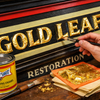Gold Leaf Across the World - France
- by Sam Wozniak
The History and Uses of Gold Leaf in France
Gold leaf, known as "feuille d’or" in French, has long been a symbol of luxury, divinity, and artistic excellence. Across France, gold leaf has played a crucial role in architecture, art, religious decoration, haute cuisine, and even modern luxury goods. Its history dates back centuries, reflecting changes in artistic trends, social structures, and technological advancements. From the opulence of Versailles to contemporary culinary and fashion industries, gold leaf remains an enduring emblem of prestige and refinement.
Historical Significance of Gold Leaf in France
The use of gold leaf in France can be traced back to the Middle Ages, though its origins globally date even further to ancient Egypt and Rome. French artisans perfected gold leaf application techniques, making them integral to religious art, palace interiors, and fine craftsmanship.
1. Medieval and Gothic Period (12th-15th Century)
During the Middle Ages, gold leaf was extensively used in religious manuscripts, paintings, and cathedral decorations. French Gothic churches, such as Notre-Dame de Paris, featured gold-adorned frescoes, statues, and altarpieces. Gold leaf illuminated the pages of illuminated manuscripts, where monks meticulously applied gold to create intricate designs in Bibles and religious texts. The technique of gilding, where gold leaf is applied to surfaces, became a defining feature of medieval French artistry.
2. Renaissance and Baroque Period (16th-18th Century)
The Renaissance brought a resurgence of classical artistic influences, and gold leaf became a vital material in French fine art and architecture. The Baroque period, particularly under the reign of King Louis XIV (1643-1715), saw an unprecedented use of gold leaf in France. The Palace of Versailles, one of the most opulent palaces in the world, was adorned with gold leaf in its Hall of Mirrors (Galerie des Glaces), gates, furniture, and chandeliers.
Artists like Nicolas Poussin and Jean-Baptiste Lully incorporated gold elements into paintings, music instruments, and court attire, reinforcing the grandeur of the French monarchy. The use of gold leaf in royal furniture, picture frames, and architectural details became a hallmark of Louis XIV’s extravagant style.
3. 19th and 20th Century: Art and Luxury Goods
During the 19th century, gold leaf continued to be used in Neoclassical and Rococo-style buildings, as well as in Art Nouveau and Art Deco movements. Gold leaf was also extensively applied to statues, bridges, and landmarks in Paris, including the Pont Alexandre III and the Opéra Garnier, symbolizing the golden age of French arts.
In the 20th century, luxury goods manufacturers in France, such as Cartier, Chanel, and Guerlain, incorporated gold leaf into jewellery, perfume bottles, and high-end fashion designs. The association of gold leaf with luxury and sophistication persisted, and its use extended beyond traditional artistic applications.
Modern Uses of Gold Leaf in France
1. Architecture and Monuments
Gold leaf is still widely used in French architectural restoration and decoration. Many historical buildings, such as the Dôme des Invalides in Paris, are covered with gold leaf to maintain their grandeur. Skilled artisans known as gilders (doreurs) continue to restore gold-covered statues, domes, and palace interiors, preserving France’s artistic heritage.
2. Fine Art and Gilding
French artists and craftsmen continue to use gold leaf in painting, sculpture, and furniture decoration. Contemporary artists incorporate gold leaf into modern abstract works, bridging traditional gilding techniques with contemporary aesthetics. Many antique furniture restorers use gold leaf to restore Louis XVI-style chairs, tables, and decorative moldings, maintaining the rich legacy of French craftsmanship.
3. Culinary Arts and Haute Cuisine
Gold leaf is widely used in France’s culinary industry, especially in pâtisserie, chocolatier, and fine dining. Edible gold leaf ("or alimentaire") is applied to:
- Luxury chocolates and truffles from prestigious brands like La Maison du Chocolat.
- Macarons and pastries, particularly those by renowned chefs like Pierre Hermé.
- Michelin-starred dishes, where gold flakes garnish meats, seafood, and gourmet sauces.
- Champagne and liqueurs, with brands like Gold Cuvée producing gold-infused beverages.
French chefs use edible gold leaf to create a visual statement of extravagance, continuing the tradition of opulent presentation dating back to royal feasts.
4. Fashion and Perfume Industry
France, the fashion capital of the world, incorporates gold leaf into haute couture designs. Designers like Christian Dior and Yves Saint Laurent have experimented with gold-infused fabrics and accessories. The perfume industry also uses gold leaf in luxury fragrances, including limited-edition bottles coated with gold leaf for aesthetic appeal.
5. Cosmetics and Skincare
Gold leaf has found its way into high-end skincare products, marketed for its anti-aging and rejuvenating properties. French brands such as Guerlain and Lancôme use gold in face masks, creams, and serums. While the scientific benefits remain debatable, the allure of gold-infused skincare attracts elite consumers.
Techniques and Application of Gold Leaf in France
French gilders use two primary techniques to apply gold leaf:
- Water Gilding (Dorure à l’eau): A traditional, meticulous method requiring multiple layers of preparation, used on furniture, picture frames, and statues.
- Oil Gilding (Dorure à la mixtion): A simpler technique used for outdoor structures like domes and monuments, ensuring durability.
Skilled artisans known as “Maîtres doreurs” (Master Gilders) train for years to perfect these techniques, preserving the centuries-old craftsmanship of France’s gilding tradition.
Conclusion
Gold leaf has been a defining element of French art, architecture, cuisine, and luxury industries for centuries. From the gilded grandeur of Versailles and Notre-Dame to its application in modern haute couture and fine dining, gold leaf remains a timeless symbol of French elegance and craftsmanship. Its versatility ensures that it continues to evolve, bridging history and modernity while upholding France’s legacy as a beacon of artistic and culinary excellence.






